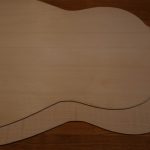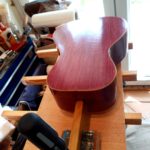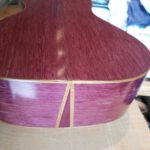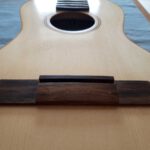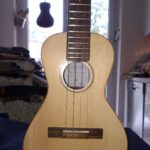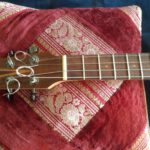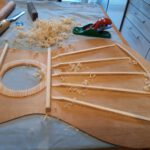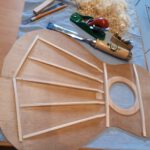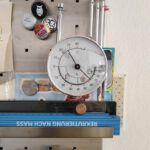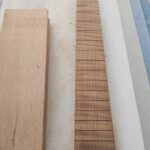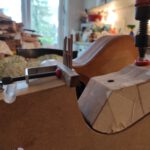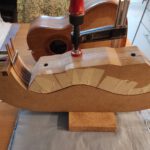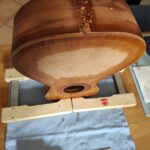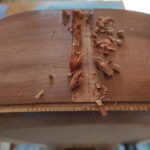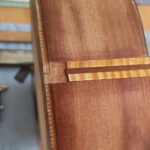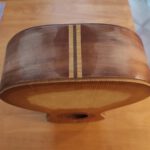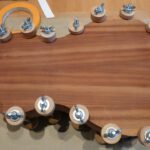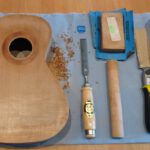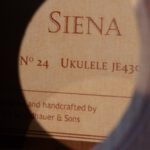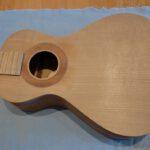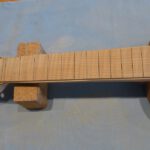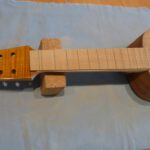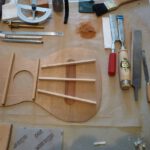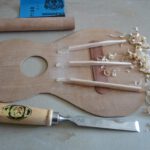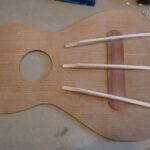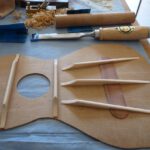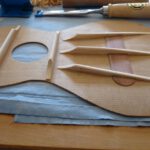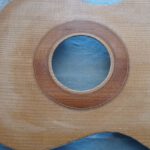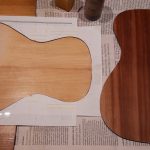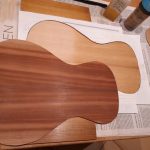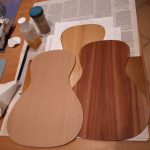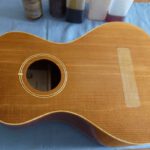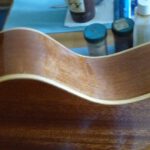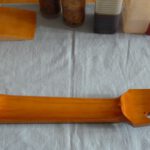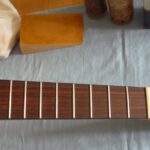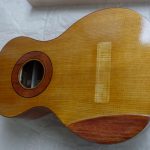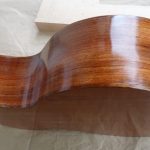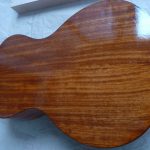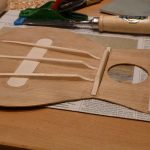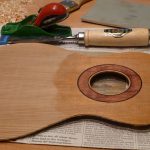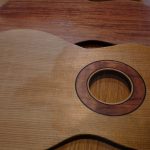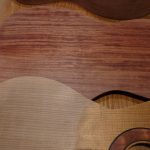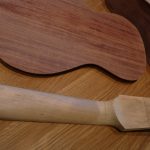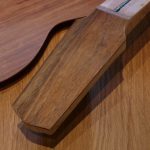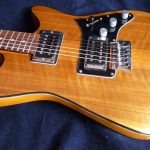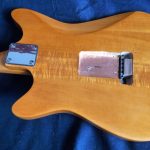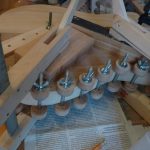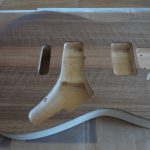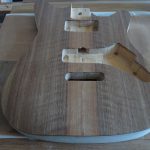Here are some of our instrument building (or restoration) projects that are currently on the bench, in progress or (recently) completed.
Sisters No. 32 Mirabelle and No. 33 Courtney
This pair has been in progress for about ten years, at least inasmuch as I joined and cut out the top and back plates for both, created and inserted the matching rosettes, cut the sound holes… and then benched the pieces
Sisters No. 30. Marley and No. 31 Marlena
Marley – bass ukulele in all sapele
This is Robin’s premier DIY build. I’ve provided some assistance (advice, spotting, etc.) but he has done all the work himself. The body is now complete and ready for fine sanding and finishing, the neck is practically done except that the fretboard needs to be attached, radiused and fretted. So all in all close to completion.
The form is reminiscent of a dreadnought guitar. The body is made of solid sapele, including the top, back, sides, neck and tail blocks. Bracing is European spruce. Rosette is a simple group of wenge, maple and sapele rings.
Scale length is 600 mm, like a short-scale guitar. We’re not sure what the tuning is going to be – it’s a bit of a balancing act: on the one hand it need to sound good (as good as possible) on it’s own, on the other hand it needs to play well in an ensemble, for example with the matching tenor uke but also with other instruments.
Marlena – terz cinquelele in all sapele
This is the matching cinquelele for the Marley. The form is a wide Jenny, like an XL tenor ukulele. The body is made of solid sapele, including the top, back, sides, neck and tail blocks. Bracing is European spruce. Rosette is a simple group of wenge, maple and sapele rings.
Scale length is 450 mm, like the April with silk&steel strings in Terz tuning. The design is very close to the Marley, but it does have a few personal touches.
No. 29 Erin – Baritone Harp Ukulele
This is a premier in several ways: baritone scale length, harp construction with fretted strings and unfretted sub-bass strings, and a 5+5 string configuration. The build has been in progress for a while now.
It has a cedar (WRC) top, with cherry back and sides, alder neck, walnut fretboard, headplate and heel, and a double walnut bridge. I didn’t have any plum pieces in the right color, so I decided to use cherry sides because they matched the light and medium colors in the plum best – a compromise, indeed, but we’ll have to live with it. Optically, I think it will work fine – tonally … who knows? Note that the plum back that I started with turned out to be too small so I cut a new back from the cherry that i had used for the sides.
This build has presented more challenges than any other. Several major ones have been:
- There is no “mid line” where everything lines up, the neck, fretboard, body, bridge, strings….
- I have not built an instrument with a string-bearing arm before and was unsure about how to stabilize it properly.
- I decided to use a string-thru bridge, but the bracing then had to be laid out in such a way that it did not interfere with the strings passing through to the bridge plate.
- The neck and arm are angled so that the two heads “kiss” each other. But that means there is not enough room for angled tuners so I used planetary banjo tuners instead. They only have a 4:1 gear ratio, which will certainly make tuning more challenging.
- Another concern has been the balance between the body and neck. The body is comparable in size to a baritone uke, but on the other side there is a tone arm in addition to the neck – with the joint at the 15th fret – and ten tuners, five on the neck and five on the arm. This means there is a lot more mass on the neck/arm end than there would be with a standard instrument. So one concern is that it will be neck heavy/top heavy and won’t balance well. I did use a considerably larger tail block of maple to help compensate the difference. I considered plugging it with copper rods to add weight but in the end decided against that.
Terz guitar/ukulele set, cedar/walnut – BENCHED
This set has been “on the bench” for a really long time – it’s a terz guitar and matching ukulele, both made from exactly the same (pieces of) wood and with matching shapes and designs. The tops and backs are cut for both and the rosettes and soundholes are complete.
Currently, I am working on the form for the guitar, as it was only rough cut and the two sides were asymmetrical. Years ago, I managed to build and then trash a ukulele body using a form that was not cut correctly, so I would rather put the effort into getting the form right this time. I’m also rounding the bout curves out a little more, just have to make sure the previously cut top and back pieces still fit. I assume I’ll want to do the same thing with the ukulele form when I get to that. The sides for both instruments are rough cut and thinned almost as far as I want them, just a wee bit to go.
Pictures to follow.
No. 22 – BENCHED
Classical guitar based on Torres/Hauser with Engelmann spruce top, flamed maple back and sides, alder neck, wenge fretboard and accents. Scale length 648 mm (subject to adjustment). Next steps are to put the tail graft in, put the rosette and soundhole in the top, and cut the slots in the headstock. Unfortunately, I’ve been spending much too much time on No. 23 lately, but I’m going to keep the numbering simply because I want this one to be No. 22 – I think.
There will be a few things that don’t line up with the Torres/Hauser precursors, in particular a bolt-on neck, a slightly radiused fretboard and probably just a simple set of rings around the soundhole instead of an intricate rosette, as the latter would take me much too long to complete – I think.
- Engelmann spruce top
- Curly maple back
RECENTLY COMPLETED – for further details, check the pages under Instruments
No. 28 April (completed 04/2022)
This is a long-scale tenor ukulele based on the Jenny form. The top is European spruce from Mittenwald, back and sides are purple heart. The neck is maple with an ovangkol fretboard, heel and headplate.
I lengthened the scale to 450 mm and put the neck joint at the 14th fret to give this uke a strong voice and improved access to the upper register, while still keeping the bridge/saddle close to the original position on the 430-12 version.
I’m currently struggling with some fret buzz in certain positions, particularly on the 3rd string. And I need to find the “perfect” set of strings – I put Martin M630 baritone uke strings on to start with, but I don’t think I really like them – although I normally swear by the Martin FCs.
- French polish on purple heart
- Tail graft – purple heart and teak
- Gluing the bridge on
- Ovangkol bridge
- Spruce top
- Maple peghead with volute and black nickel tuning machines
- Ovangkol fretboard and headplate – with purpleheart and teak inlay
Sisters No. 26 (June) and No. 27 (Joanne)
Update 15 May 2021
These two instruments are now practically parallel in their development: I just closed the box on No. 26 and am ready to do so on No. 27 as soon as I decide what kind of glue to use. I never really use anything but hide glue, except sometimes CA on bindings and such. My only question in this case, is whether the areas shielded with copper tape will glue correctly, if at all, with hide glue. I did a small test but still am not sure. The reason I don’t really want to use epoxy is that I’m concerned about the squeeze-out getting all over the place, especially in the binding channels that are already cut in the top and body pieces. So final decision is pending on this one.
I actually went ahead and cut the binding ledges on No. 26 yesterday. I made a little wooden jig plate to hold the Dremel on to compensate for the dome, especially on the back. Unfortunately, there was an issue with the jig bumping into the little amber inlay that sticks up from the rosette – I’ll need to fix the ledge on one side. A tiny piece chipped off on the lower bout ledge – to be expected, I suppose, considering how brittle the wood is. I’ll have to keep that in mind when thinning the edges of the top.
I’m going to be using maple binding strips, just like on the Jenny. The pieces are actually 2 x 6 mm, but I decided to go for 1.5 x 5 mm on the ledges – I would rather trim and sand the binding flush than the sides.
No. 26 – June B – Chamber Guitar Sapele/Spruce (completed Jan 2022)
See the June B page in the Instruments section for more.
Update 14 Nov 2021: June is now almost completed – only a few final steps to be taken
- affix the bridge (once the polish is completed and cured, so probably not till December or even January)
- final shaping of the saddle and nut
- final setup, adjustments, etc.
I’m now putting the polish on, which I actually don’t like doing in November, but I can’t bear to wait till next year.
Update 18 Oct 2021: A lot has happened with this instrument since the last update. I “closed the box” back in May, bent the maple binding strips and cut the binding channels, and also did a very basic shaping of the neck. Then I put everything on the shelf to work on Joanne, which I finished just recently.
The outline of two boxes, by the way, is practically identical.
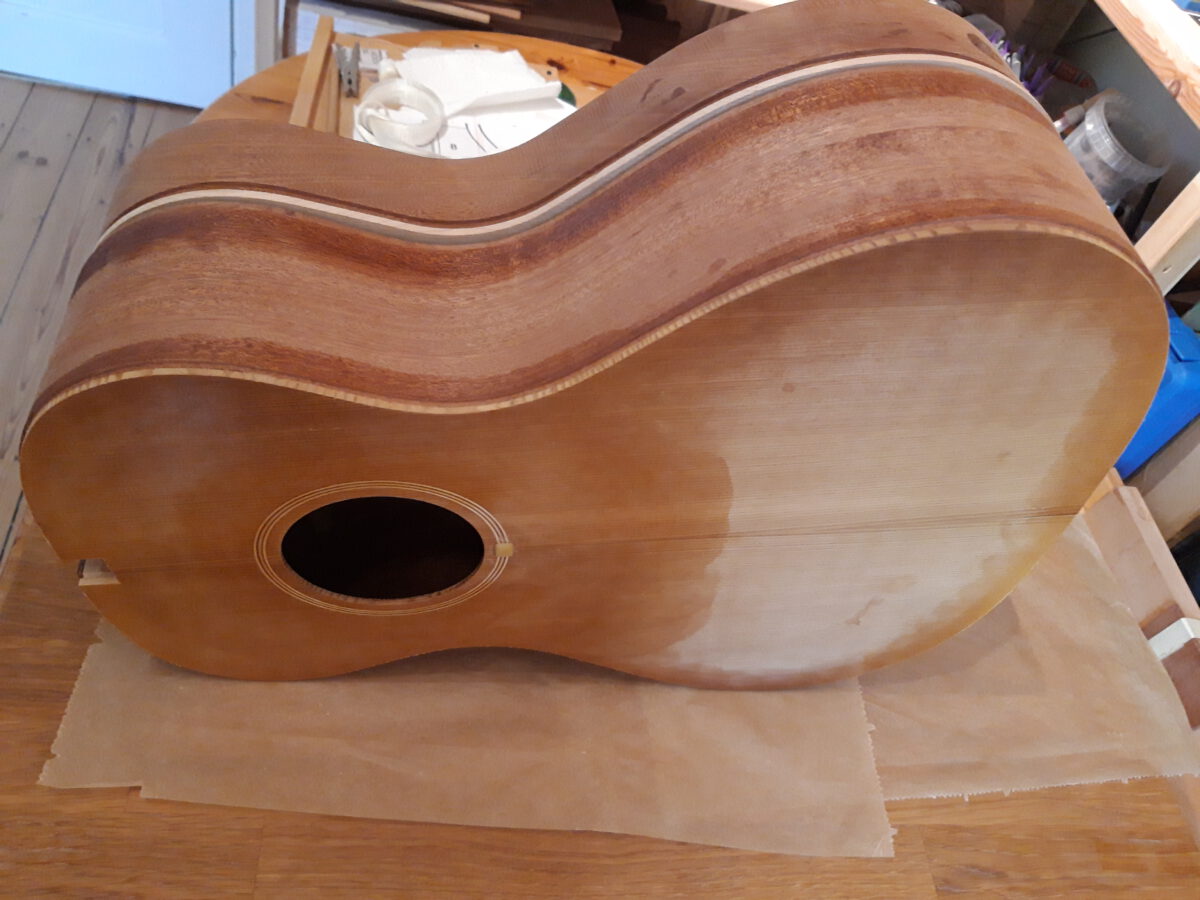
So now I’m back to working on June and have since then
- cut and inlaid a tail graft in flamed maple
- glued in the maple binding strips and sanded them flush
- thinned and narrowed the neck
- fiddled and whittled the neck joint almost to the point of insanity, only to discover that I had actually created a “secret feature” whereby you can adjust the neck angle by slightly loosening or tightening the bolt connection
- shaped and slotted the fretboard
- thinned the headstock and attached a cover plate made from the same piece of rosewood as the fretboard with continuous grain lines (as with the Jenny)
Update 28 Mar 2021: Top bracing is (almost) completed – still need to taper the ends of the lateral braces to 2 mm. Then mark and cut them to length and cut the notches in the lining. I want to get the top attached to the sides as soon as possible.
Unfortunately, I don’t have a solera or working board with the correct radiuses so I’ll either have to make one or figure out some other way of maintaining the dome while I put the pieces together. With the Jenny I just made a ring out of spruce veneer that I placed under the edges of the top so that the table top just barely touched in the middle of the lower bout. That worked well, so I might try that again.
Update 14 Feb 2021: June is coming along, slowly but surely. Sides are now ready for assembly, top and back are joined, and I’ve bent several strips for the soundhole ring. Unfortunately, all the walnut pieces broke except one, so we’ll either have to go with one simple maple-walnut-maple ring like on the Jenny, or use some other wood with the maple – I managed to do two rings in wenge, which would be a lot darker than the walnut but might look quite nice.
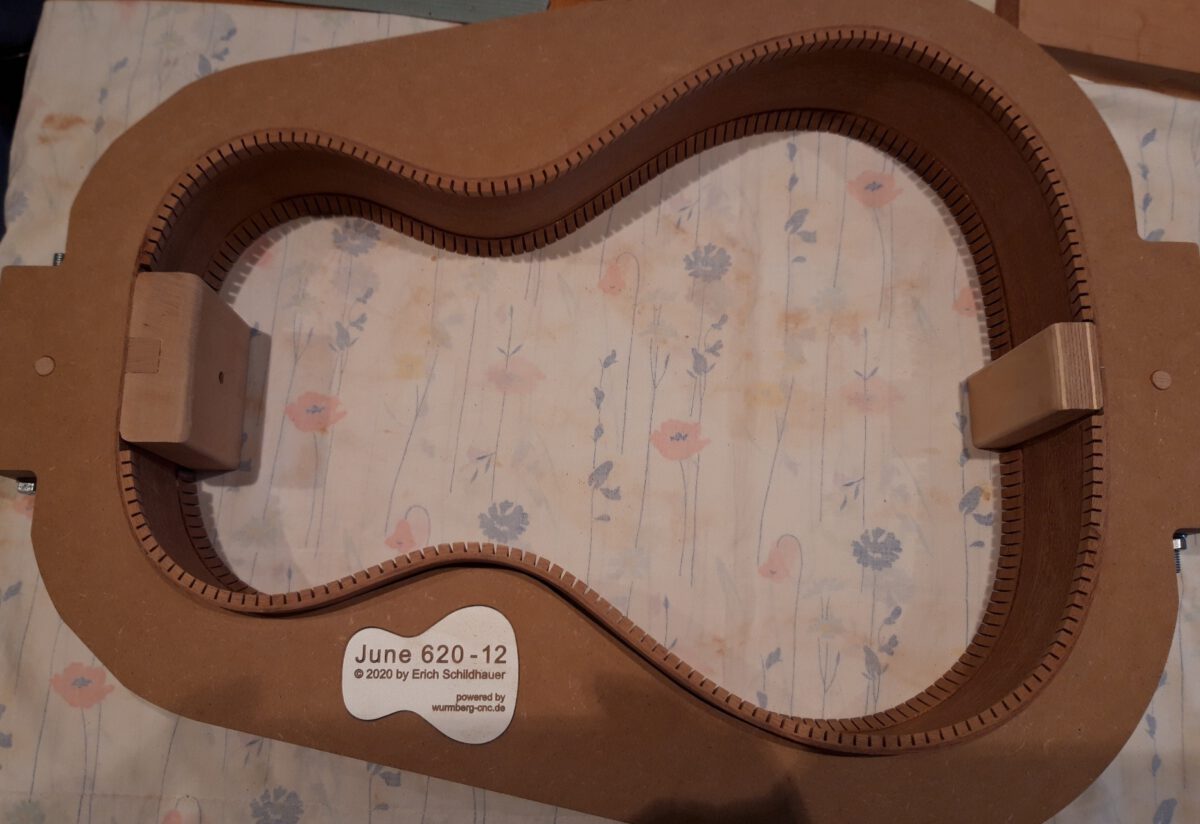
—
This is a new guitar form that is intended as the “big sister” of the Jenny ukulele form. The first run will have the same wood combination as the Jenny No. 25, so they will hopefully turn out as a pair of instruments that stays together. Currently a scale length of 620 mm is planned, but there is certainly some leeway to shorten by 10 or even 20 mm, or even to go up to 630 mm.
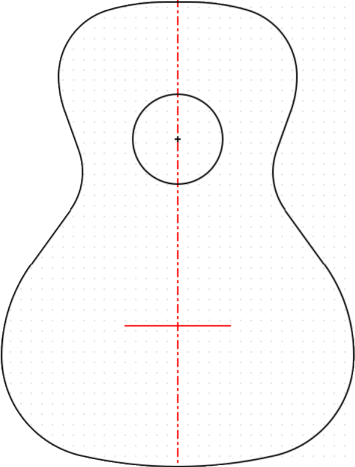
No. 24 – Siena – taro patch (8 string) ukulele, spruce/plum
Update 6 Mar 2021
Well, she’s finally on her way to Kauai’i. I managed to put a good ding in the upper bout while changing strings and we all decided that it would be best to refinish the top, so I did. The finishing was fairly quick, but of course it takes forever for shellac to cure. I once made the mistake of putting the instrument in a case too soon after I thought the finish was dry and then had a blemish on the top, so this time I wanted to be more careful. I really hope I waited long enough…
Finding a case was a real ordeal – almost as bad as our Artcore AWD120 – been looking for a case for that beauty for so many years… What I ended up sending it in was a BR Noir for Tenor Ukulele. It’s not really snug, so we put a little velvet wrap around the body to keep it cozy, warm and safe as a field of daisies.
Update 18 Aug 2020
The Siena is coming along at a rather slow pace. Not only am I currently involved in a big work project, but the weather has been unbearable lately – a record heat wave and the typical high humidity levels that you get here in August. So I can’t share all that much, just a few next steps and photos. I’ve now fine-fitted the neck/body joint, burnished the maple fretboard, bent the binding strips and added the tail graft. I hope I’ll be able to glue the binding soon, and then the fretboard.
- Hot and humid – ughhh
- Roasted flamed-maple fretboard
- Flamed, roasted, burnished maple
- Binding strips clamped together at one end
- Jenny form with bent binding strips
- Two cam clamps to hold the body
- Tail graft slot . cut with an extra-fine exacto saw and a narrow chisel
- Fits just right
- Siena – tail graft and binding ledge
Update 18 July 2020
I “closed the box” a few days ago and am now ready to put the bindings on – probably walnut, but I may decide to go for maple… we’ll see how the walnut looks. I’m also working on fine tuning the neck joint to get the action just right. Progress has been slow but still fairly steady recently, but – for better or worse – I have a new work project that begins in a few days, so I probably won’t be able to do very much before October.
Originally, I was planning to call this one Amber, but the colors of the plum wood didn’t seem to fit the name, and I also was uncertain whether the color scheme of amber was really well known elsewhere. So I started thinking about other names and in the end came up with Siena, which I think fits the palette quite well. And it also alludes to the beautiful city in Tuscany with its cathedral and marketplace and…
- Siena – “Closing the box”
- Siena – Toasted spruce top
- Close up of the label, through the soundhole, under the kitchen lights, with one hand
- Siena – Top, rosette, fretboard
- Siena – Toasted maple fretboard
- Siena – Toasted maple head plate and fretboard
Update 23 June 2020
Now that the work on Jenny B is nearing completion, the TP uke is back on the bench…. again.
I bent the sides a while ago and have glued and flattened the linings. With the sides almost ready, I have now started with the bracing of the top. Just as a reminder: this is the third top I’ve now made for this ukulele (see the original post below for more details).
- Baked spruce top with plum bridge plate and spruce brace blanks
- Fan braces glued and rough-shaped
- Fan braces *almost* finished
- Spruce top braces – TP uke
- Bracing almost completed
- Plum rosette with walnut rings
26 May 2019
Well, the work on the taro patch ukulele for my brother has been a really bumpy road. I’m now working on the third top for this instrument.
The first one was a piece of spruce that I only “baked” for a very short time, and I decided the color wasn’t golden/amber enough, so I’m going to put that top on a different instrument.
The second one turned out a really pretty amber color. I used a simple 3-ring rosette on it and had all the braces glued and shaped. It was all ready to go, then I had to leave for several weeks on an extended project assignment and when I got back… the top wood had bent itself around the other way so there was a slight dip in it, rather than the slight dome it had before!
Anyway, I’m not one to give up easily, so I tried bending it all back the right way on the bending iron and while I was at it the edge of the lower bout snapped and broke off. Needless to say, more than a few tears were shed that evening. I ended up taking off all the braces, whereby some damage was caused when I removed the middle fan brace. I did manage to glue the edge back on, and the joint looks very good, practically invisible, and is absolutely stable, so I may put this piece on some other instrument.
The third and hopefully final top is in the making right now. It is also made of baked spruce, this time with a fairly dark amber color. The rosette is made from a leftover piece of plum wood with a ring on either side.
Pictures to follow.
This is planned as the replacement ukulele for my brother – check the description of No. 21 – Wana’ao to find out more.
I was able to get some nice pieces of plum wood from one of my favorite sawyers and I found a lovely piece of cedar that was exactly the right size (check the picture on the right). However, I’ve been playing the Wana’ao a lot lately and have been so pleased with the color, glow and fantastic sound of the baked spruce that I decided to use a piece of the same wood on this one.
On a side note, I found the invoice for the bubinga I bought back in 2008, so I could actually apply for export/import of the Wana’ao from Europe to the US. I don’t know if I want to bother with the hassle, so I’m simply going to continue with this build as if it were my calling card in Hawaii. But the Wana’ao would certainly fit the bill as well.
More to follow.
No. 25 – Jenny – Tenor ukulele, spruce/mahogany
Update 19-06-2020:
Jenny is coming along nicely, now that I have had the time to continue working on her.
After struggling with the exact alignment of the original mahogany neck, I decided to put that neck away and make a new one, this time in alder, my standard neck wood. I also decided to use a piece of rosewood for the fretboard instead of ovangkol. So this will be the first instrument where the list of “ingredients” on the label isn’t quite correct, as the Mh Ov for neck and fretboard would actually have to be Al Rw.
All that’s left is to complete the polishing, let the finish cure, glue on the bridge and attach the tuning machines. So, it could be a couple weeks, or a couple months… depending on the weather.
- Baked spruce top – Jenny
- Mahogany back and sides – out of focus, sorry
- Alder neck with volute – Jenny
- Rosewood fretboard – Jenny
This is a first run of my new tenor ukulele form – it’s called Jenny. The top is baked spruce, the back and sides are solid mahogany. Currently in progress, sides are bent, top and back are cut, rosette inlaid, bracing is cut and ready to glue. The neck is near completion – unfortunately I made an error marking the neck at some point, so it is a little too long. I haven’t decided whether to
- Put it away for some other instrument and make a new one (which would be a lot of extra work)
- Place the nut closer to the body, but it’s off by quite a bit an I think that would look really odd
- Use a longer scale length (440 or more)
- Use a slightly shorter scale length (about 425) and join at the 13th fret instead of at the 12th
Voting is still out on this one, so let me know what you think.
No. 21 – Wana’ao – Completed 08/2018
Update 15 Aug 2018: Well, she’s pretty much finished, all I have to do is glue on the bridge and screw on the tuners – and optimize the setup, of course. Here are a few pictures of the body with shellac/oil finish.
This is an eight-string tenor ukulele for my brother who lives on Kauai. The top is thermo-treated German spruce with a nice honey color and very pretty, glowing silk. The back and sides are bubinga. I kept the three fan braces that I normally use on a tenor uke and just added a little height to them, and I also used a bridge plate (for the first time in quite a while).
No. 23 – Jasmine – Completed 08/2018
Update 29 Aug 2018: The order of completion has taken a turn, if not to say a loop. The e-guitar with walnut top is now practically completed. Numbering remains the same, however. We chose the name “Jasmine” for this one. The back plate still need to go on, though it isn’t really necessary. And I am considering adding a piezo, but that’s still just an idea.
- Jasmine
Slight change of plan. E-guitar with alder body, figured walnut top, figured maple neck, rosewood fretboard. I haven’t decided whether to polish the back and sides in black shellac, possibly with a bwb binding, or in cognac/amber shellac with black binding. I’m planning to use a black pickguard, Tonerider AC2 pickups, Fender scale length 648 mm. All subject to change and adjustment.
- Hide glue, of course…
- Pockets routed…
- Kinda nice, I think…

